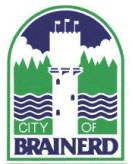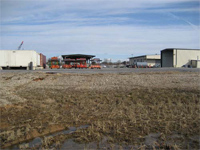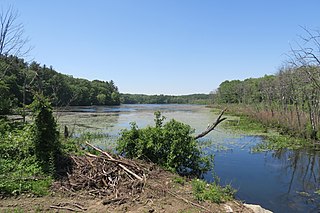
Crow Wing County is a county in the East Central part of the U.S. state of Minnesota. As of the 2010 United States Census, the population was 62,500. Its county seat is Brainerd. The county was formed in 1857, and was organized in 1870.

Baxter is a city in Crow Wing County, Minnesota, United States. The population was 7,610 at the 2010 census. It is part of the Brainerd Micropolitan Statistical Area.

Brainerd is a city in Crow Wing County, Minnesota, United States. Its population was 13,592 as of the 2010 census. It is the county seat of Crow Wing County, and is one of the largest cities in Northern Minnesota. Brainerd straddles the Mississippi River several miles upstream from its confluence with the Crow Wing River, having been founded as a site for a railroad crossing above the confluence. Brainerd is the principal city of the Brainerd Micropolitan Area, a micropolitan area covering Cass and Crow Wing counties and with a combined population of 91,067 as of the 2010 census. The Brainerd area serves as a major tourist destination for Minnesota.

Environmental remediation deals with the removal of pollution or contaminants from environmental media such as soil, groundwater, sediment, or surface water. Remedial action is generally subject to an array of regulatory requirements, and may also be based on assessments of human health and ecological risks where no legislative standards exist, or where standards are advisory.

The Hercules 009 Landfill Superfund site is a 16.5-acre (67,000 m2) property that is bordered by Georgia State Route 25 on the west; an automobile dealership on the north; a juvenile slash pine forest on the east; and several homes, a church, a school, and a strip shopping center to the south/southeast of the property. Hercules was issued a permit in 1975 by the GaEPD to use 7 acres (28,000 m2) at the northern end of the property as a landfill to dispose of toxaphene-contaminated wastewater sludge generated during the manufacturing processes. The 009 Landfill was constructed at the northern end of the property as six cells, each approximately 100 to 200 feet (61 m) wide and 400 feet (120 m) long. Toxaphene has been detected at levels exceeding 15,000 parts per million at the Hercules 009 Landfill Site.

Havertown Superfund is a polluted groundwater site in Havertown, Pennsylvania. The state initiated legal action against the owners in 1973 to force them to cleanup the site. The site was added to the National Priorities List in 1983 and designated as a Superfund cleanup site in early 1990s.
An injection well is a device that places fluid deep underground into porous rock formations, such as sandstone or limestone, or into or below the shallow soil layer. The fluid may be water, wastewater, brine, or water mixed with chemicals.
Groundwater remediation is the process that is used to treat polluted groundwater by removing the pollutants or converting them into harmless products. Groundwater is water present below the ground surface that saturates the pore space in the subsurface. Globally, between 25 per cent and 40 per cent of the world's drinking water is drawn from boreholes and dug wells. Groundwater is also used by farmers to irrigate crops and by industries to produce everyday goods. Most groundwater is clean, but groundwater can become polluted, or contaminated as a result of human activities or as a result of natural conditions.

The American Creosote Works Superfund site is an inactive wood-treating facility in Pensacola, Florida located about a quarter-mile north of the confluence of Bayou Chico and Pensacola Bay. The Superfund program of the United States Environmental Protection Agency (EPA) protects the public and the environment by requiring cleanup of the nation’s worst hazardous waste sites.

Brown & Bryant Inc. was a chemical distribution company located in Arvin, California in Kern County. The land the company operated on is designated as a U.S. Environmental Protection Agency (EPA) Superfund cleanup site. The company was a formulator of agricultural chemicals including fertilizers, herbicides, insecticides, and fumigants.

The Escambia Wood Treating Company (ETC) site is located at 3910 Palafox Highway, northeast of the intersection of Fairfield Drive in Pensacola, Florida, and is in a mixed industrial, commercial, and residential area (2)(4). The site includes the 26-acre property of the former wood preserving facility and over 60 acres of nearby neighborhoods (1)(4). The facility was in operation from 1942 until 1982, then abandoned by the owner in 1991 (4). During its operation, ETC treated utility poles, foundation pilings, and lumber with creosote and pentachlorophenol (6). Production byproducts were dumped into onsite, unlined containment pits where they seeped into the surrounding soil and groundwater (6).
The Arrowhead Refinery Superfund site is a 10-acre former waste oil recycling facility, located in Hermantown, Minnesota, within a white cedar wetland. The refining process generated a waste stream of highly acidic, metal-laden sludge which was disposed of in an unlined two-acre lagoon on the site and waste process water which was discharged into a wastewater ditch in a wetland area. Arrowhead Refining Company incorporated in 1961 and continued the re-refining activities until 1977. A public health risk assessment stated that if no action was taken to remedy the site, use or development of the site would result in unacceptable health effects on user populations. It was also determined that there was a future potential exposure risk for offsite drinking water wells across the road from the site and in the pathway of the contaminated groundwater plume. The record of decision (ROD) was issued in September 1986.
The Oakdale Dump is an Environmental Protection Agency Superfund site located in Oakdale, Minnesota, and comprises three non-contiguous properties that were used for dumping from the late 1940s until the 1950s by the 3M corporation. The properties are named the Abresch, Brockman, and Eberle sites for their respective property owners at the time of disposal activities. The Abresch site is the largest of the three properties at about 55 acres. The Brockman site is located immediately southwest of the Abresch site and encompasses 5 acres. The Eberle site is located roughly 2,500 feet north of the Abresch site and encompasses 2 acres.
The FMC Corporation is a United States Environmental Protection Agency Superfund site of 18 acres (7.3 ha) in Anoka County, Minnesota, United States, several hundred feet east of the Mississippi River. Solvents, paint sludge, and plating wastes were generated and disposed of in an on-site dump from the 1940s until 1969. Minnesota Pollution Control Agency (MPCA) staff sampled site surface and groundwater in the early 1980s and confirmed that ground and surface water were contaminated by industrial solvents. In the 1980s, solvents from the site were detected in the city of Minneapolis drinking water system intake that is located downgradient of where the FMC site groundwater contaminant plume enters the river.

The Koppers Co., Inc. (KCI) Superfund Site is one of three Superfund sites in Oroville, California, along with Louisiana Pacific Sawmill and Western Pacific Railyard. The KCI Superfund Site is a 200-acre site which served as a wood treatment plant for 50 years. Wood was treated with many chemicals to prevent wood deterioration. The accumulation of these chemicals from spills, fires, and uses has caused this site to be contaminated with the hazardous waste material. Due to soil and groundwater contamination, the site was placed on the National Priorities List in 1984 for remedial action plans to clean up the site to protect surrounding residential areas concerning environmental and human health risks.
The Ashland/Northern States Power Lakefront Superfund site is a contaminated region of the Wisconsin shoreline of Lake Superior that is being studied for remediation by Northern States Power Wisconsin (NSPW), as well as the Environmental Protection Agency (EPA), the Wisconsin Department of Natural Resources (WDNR). This site has held a manufactured gas plant from 1845 to 1947, as well as lumber manufacturing and treatment mills for four decades at the start of the 20th century, railcar loading facilities, and a municipal landfill. Additionally, a wastewater treatment plant is located on the premises, but is not in operation. Contamination of the site is currently believed to have been caused by all the parties mentioned above, or former owners of the property whose companies are no longer in business. The area is listed as a Superfund site by the EPA under the Comprehensive Environmental Response, Compensation, and Liability Act (CERCLA). Releases of hazardous substances occurred onshore and migrated into sediment in Chequamagon Bay on Lake Superior.

Hocomonco Pond is a recreational pond located in Westborough, Massachusetts near Route 9. Also called Hobomoc Pond, it was named for Hobomok, a Wamesit Indian evil spirit. The pond and adjacent land are a Superfund site.

Groundwater Pollution occurs when pollutants are released to the ground and make their way down into groundwater. This type of water pollution can also occur naturally due to the presence of a minor and unwanted constituent, contaminant or impurity in the groundwater, in which case it is more likely referred to as contamination rather than pollution.
Kauffman & Minteer Inc. (K&M) was an industrial transportation company that operated from 1960 to 1981 in Burlington County, New Jersey. After cleaning their trucks, they dumped the waste water into a nearby lagoon that was not properly lined. The lagoon flooded and the waste water containing chemicals, migrated over to wetlands, causing damage to vegetation and seeping into underground drinking water. The Environmental Protection Agency (EPA) got involved in 1989 and conducted a few remediation attempts but the extent of the damage is hard to determine as the different underground pathways of water are unpredictable. The site is currently an active superfund site that is closely monitored by the EPA.
The Federal Creosote Superfund site is a 50-acre (20 ha) property located in Manville, New Jersey. It was used as a wood treatment facility. Starting in 1919, the site was contaminated with creosote. Creosotes are a category of carbonaceous chemicals formed by the distillation of various tars and by pyrolysis of plant-derived material, such as wood or fossil fuel. They are typically used as preservatives or antiseptics. It took the EPA about 18 years to cleanup the site.











